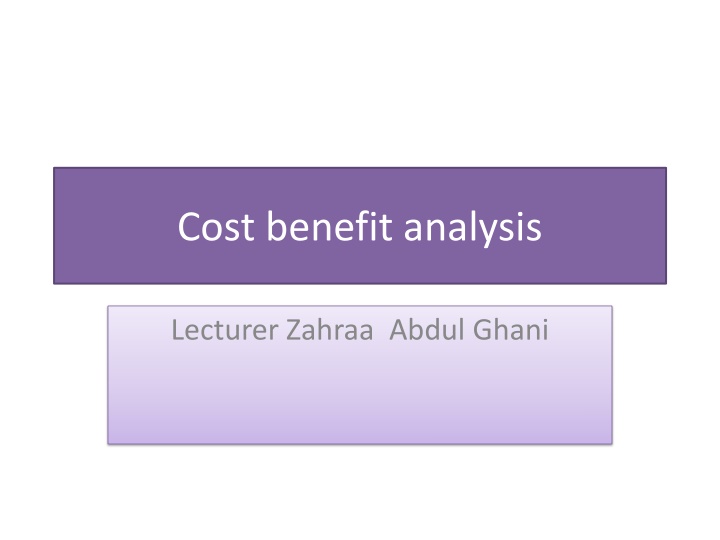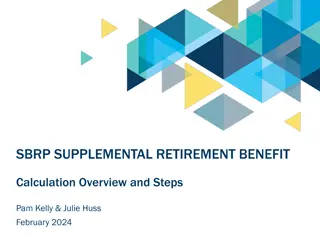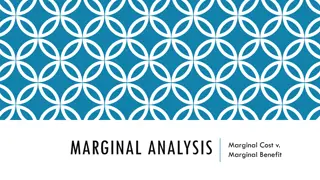Cost-Benefit Analysis: Advantages, Disadvantages, and Program Selection
Cost-benefit analysis (CBA) evaluates the costs and benefits of different programs in monetary terms, aiding decision-making. Learn the pros and cons of CBA, how to select programs based on cost-effectiveness ratios, and the significance of benefit-to-cost ratios in maximizing investments.
Download Presentation

Please find below an Image/Link to download the presentation.
The content on the website is provided AS IS for your information and personal use only. It may not be sold, licensed, or shared on other websites without obtaining consent from the author.If you encounter any issues during the download, it is possible that the publisher has removed the file from their server.
You are allowed to download the files provided on this website for personal or commercial use, subject to the condition that they are used lawfully. All files are the property of their respective owners.
The content on the website is provided AS IS for your information and personal use only. It may not be sold, licensed, or shared on other websites without obtaining consent from the author.
E N D
Presentation Transcript
Cost benefit analysis Lecturer Zahraa Abdul Ghani
Cost benefit analysis compares both costs and benefits in monetary units.so the costs of different program options can be directly compared. CBA is often used to evaluate investments in large-scale programs, such as national strategies for vaccination or HIV treatment, recommendations to increase screening for disease ,or investments in health insurance or infrastructure.
Advantages and Disadvantages of CBA An advantage of this type of analysis is that many different outcomes can be compared as long as the outcomes measures are valued in monetary units. The disadvantage is that placing economic values on medical outcomes is not an easy task and there is no universal agreement on one standard method for accomplishing this.
Table 7.1 shows examples of various programs and interventions and their corresponding cost- effectiveness and cost-benefit ratios. (CBA ratios are expressed as benefit-to-cost ratios, where the higher the number, the more cost-beneficial.) Assume you are a decision maker and you must choose one program from Table 7.1 to implement in your organization. Assume that you only had cost-effectiveness ratios available to help make the choice. How would you choose?
One can quickly see that it would be difficult to compare the programs using only cost-effectiveness ratios because of the varying outcomes (e.g., case prevented, life years saved). On the other hand, the benefit-to-cost ratios can be ranked, and programs with similar, as well as dissimilar, outcomes can be compared. In addition, the decision maker can determine which programs costs will exceed the benefits and vice versa. If the goal of the decision maker is to maximize the investment, the program with the highest benefit-to-cost ratio (in this case, diabetes medication adherence program) would be chosen. If only the cost-effectiveness ratios were available, it would be more difficult to compare the value of the various interventions.
Do the benefits of a program or intervention outweigh the costs? Which program will provide the greatest benefit? CBA is a tool that can be used to address these questions. The unique aspect of placing a monetary value on the outcome or benefit in CBA also presents a challenge or disadvantage of the method. For example, when comparing the cost-effectiveness ratios for an AIDS prevention and awareness program with the vaccination program for children, it would appear that the vaccination program would be the most cost-effective. But, when examining the benefit-to-cost ratios, the AIDS program is more cost-beneficial. CBA uses methods to value morbidity or mortality lost from a human life. In this example, the benefit (case prevented) was valued higher for AIDS patients than vaccinations for children.
Conducting A CBA Figure 7.1 shows the basic components of CBA. As shown, there are two categories of costs, direct medical and direct nonmedical, and three categories of benefits, direct benefits (both medical and nonmedical), indirect benefits (productivity), and intangible benefits.CBA can incorporate as few as one category of benefits or as many as all three of the benefit categories. When only direct medical benefits are measured, some researchers do not consider this to be a true CBA. It is sometimes categorized as a cost comparison or cost analysis. Some researchers only consider an analysis to be a true CBA if, in addition to the direct benefits, a monetary evaluation of the indirect benefits, other sector savings, or the actual health benefits (using, for example, willingness-to-pay [WTP] measures) are incorporated into the analysis.
Measuring Indirect and Intangible Benefits Various methods have been developed to estimate the monetary value of health benefits. The two most common methods seen in the pharmacoeconomic literature are the HC approach and the WTP approach. 1. Human Capital Method The HC approach is one way to measure indirect benefits. HC estimates wage and productivity losses because of illness, disability, or death. The HC approach assumes that the value of health benefits equals the economic productivity that they permit. There are two basic components to calculating HC: wage rate and missed time (days or years) because of illness.
a. Wage Rate Calculations a yearly wage rate or a daily wage rate can be calculated. A yearly wage rate (income per year) would be calculated for a program or intervention that would reduce long-term disability or death. For example, a pneumococcal vaccination program might result in preventing premature death. Thus, it would be appropriate to use a yearly wage rate and assess the value of the number of years saved because of the intervention. Note that income or wages should include fringe benefits. A daily wage rate (income per year divided by number of days worked per year) may be calculated for a program or intervention targeted at an acute or chronic illness with short-term disability.
A person may not be adversely affected by the disease state on a continual basis, but he or she may have short-term periodic disability. For example, asthma, a chronic disease state, may include episodic asthma attacks. Thus, a person may only experience problems with the disease state on a periodic basis. For this type of disease state, a daily wage rate would be calculated. To calculate a daily wage rate both income and number of days worked per year must be assessed. We may assume that the average person works 240 days a year when accounting for weekends, vacation, and sick leave. A formula to calculate number of days worked per year is: Number of days in a year (365) - Number of weekend days (104) - Number of vacation days (14) - Number of sick-leave days (7) = 240
a. Missed Time (Days or Years) Because of Illness If a yearly wage rate is calculated, then assessment of the number of years lost because of a disease or illness must be made. If a daily wage rate is calculated, an assessment of the number of missed days because of illness must be calculated. Because many pharmaceutical interventions involve chronic disease states with intermittent episodes, we will use an example calculating the daily wage rate and number of missed days. Missed days because of illness can fall into four groups.
In an asthma clinic example, we will calculate an indirect benefit. Assume that the population served by the clinic is made up of adults with an average income (including fringe benefits) of $40,000 and 240 days worked per year. The daily wage rate (average income/number of days worked per year) would be $40,000/240 = $167/day. An average of 20 days a year were missed from work before participating in the asthma clinic, and an average of 7 days a year were missed from work after participating in the asthma clinic. Multiplying the daily wage rate times the number of missed days results in the value of lost productivity. In other words, the value of 20 days lost from work is $3,340, and the value of 7 days lost from work is $1,169. The difference between before and after the program is $2,171, which is the cost savings or the indirect benefit of the program or intervention























